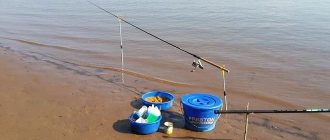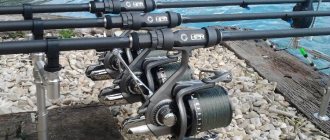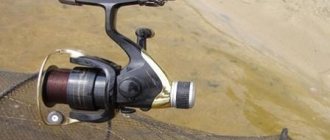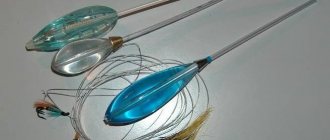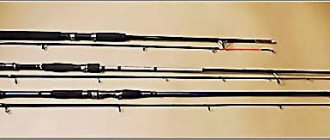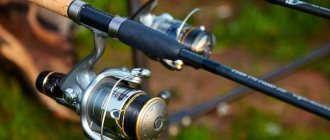Yuri 11/16/2020 193
Match rods are designed for long-distance fishing, when fishing conditions do not justify the use of a feeder. Among beginners and experienced fishermen, match tackle is becoming increasingly popular. The series of float tackle also includes a Bolognese and a fly rod. How do they differ, and what is the peculiarity of match fishing?
Characteristics of match gear
Match gear, designed for catching wary fish in areas of a reservoir distant from the shore, was invented in England.
Its second name is Nottingham. It is based on a float tackle with a special float, cast using a match rod. The float used in such equipment is called “Wagler”.
It has one attachment point to the fishing line, a fairly significant own weight and loading, which allows you to throw the bait with a small sinker.
What is a match rod? This is a form, in the vast majority of cases, of the plug type, consisting of three elbows, having 12 to 20 guide rings, a reel seat and a handle. It is most advisable to use such tackle when casting bait at a distance of 20 meters or more.
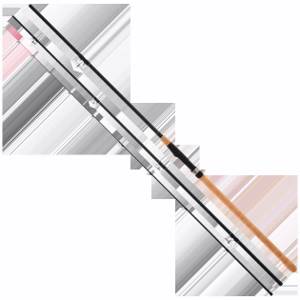
Interesting! The guide rings on the match rod are mounted on fairly high legs. This allows wet fishing line not to stick to it during fishing, which ensures increased sensitivity of the entire gear.
Occasionally in stores you can find a telescopic match rod, but they are not particularly popular, since they do not provide the balance and strength necessary for this equipment when casting bait and fishing for a trophy.
fishing line
When choosing fishing line for match fishing, preference is given to special series for this fishing method. The difference between such monofilament and simple thread is its high strength, dark colors and negative buoyancy - it should sink and not float on the surface of the water.
The thickness of the fishing line depends on the casting distance:
- when fishing at a short distance from the shore (no more than 30 meters), use a fishing line with a cross-section of 0.12−0.16 mm;
- When fishing at long distances (more than 50 meters), as well as when catching large carp and carp, use a fishing line with a cross-section of 0.18−0.22 mm.
For the leash, a thinner line is used - 0.02-0.04 mm smaller in cross-section than the main one.
Braid is not used for match gear, since compared to monofilament it has greater abrasive properties, wearing out the inner surface of frequently located guide rings. It also doesn't sink as well as matcha line.
Of all the fishing lines presented, the most popular among match fishing fans are products from the following brands:
- Maver;
- Colmic;
- Milo;
- Trabucco;
- Shimano.
Sinking lines for match fishing can be easily recognized by the inscription on the reel - the name of the line should contain the words Math and sinking. This marking will mean that the monofilament is sinking and is intended for fishing with match gear. The name of a fishing line intended for match fishing for carp will contain the word Carp.
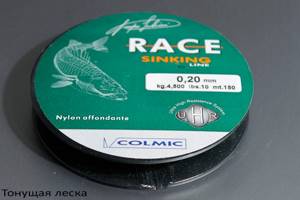
Gear device
A match rod is a multi-legged plug or telescopic blank with a reel seat and guides. Its length can range from 3 to 7 meters; rods up to 4 meters long are most often used.
In match fishing, spinning reels are used, which allow long casts of light equipment.
Monofilament fishing lines are used. The best choice for catching the carp family for a match is a thin and heavy sinking line, quite elastic, without a memory effect.
In match fishing, special floats are used, which are distinguished by their large weight (a weight is attached to the lower part of the float) and good aerodynamic properties. They allow you to deliver bait to the fishing point, making long casts.
Several weights - pellets - are placed on the main line below the float. The length of the leash and the thickness of the fishing line for it, as well as the size of the hook, are selected based on the fishing conditions, the bait used, the size and activity of the fish.
Blind and sliding equipment
The float can be fixedly fixed on the fishing line (blind equipment) or be able to slide along it between two stoppers (sliding equipment, slider).
The first option is used when fishing at relatively shallow depths, not exceeding the length of the rod. For example, with a four-meter blank, using a blind rig will be the best option when fishing at a depth of up to three and a half meters.
In a blind rig, the float is attached to the fishing line using one or two cambrics.
In a situation where the depth at the fishing point is greater than the length of the blank, the use of blind equipment will lead to difficulties when casting and retrieving. In this case, sliding equipment is used: a sliding float is located on the fishing line, and a stopper is located above it.
Let's look at the tactics of fishing with a match fishing rod
The match fishing rod is designed to perform long casting, initially determining the fishing location and feeding it even before the start of fishing. To cast, we focus on the opposite bank. To mark a constant casting distance, we place a special marker on the main line of the fishing rod.
When searching for a promising fishing spot, we pay attention to the state of the bottom, weather conditions, and everything that will help you navigate in the search for a trophy. The immersion depth of the equipment must be set so that the bait and bait are located at the bottom.
We use balls for feeding. However, since in rare cases the fishing distance does not allow throwing a ball with bait, special bait slingshots are used. Their tension force allows for long-distance and accurate casting of bait. The bait can have classic bait mixtures with mini-boilies, chopped worms, maggots or bloodworms, all kinds of grains, porridges or cereals. We supplement the fishing point with the help of a slingshot, but we are already making small balls - not as with starter feeding.
- Attention! In most cases, a match fishing rod is accompanied by the use of sliding equipment, so fishing in fast currents is not possible.
The classic match is characterized by fishing on a pond with excellent results in calm water. The match fishing rod acts as the main competitor of the feeder tackle - casting range, sensitivity, efficiency of fishing. The fisherman does not constantly fill the feeder with bait, but feeds it with balls using a slingshot. This does not slow down the fishing, which cannot be said about feeder fishing, when you have to constantly fill the feeder with bait.
Gear device
Depending on the intended fishing location, the characteristics of the reservoir, as well as the expected trophies, the choice of match rods should be made by assessing their main characteristics, including:
- Length of the form when assembled;
- Rod test;
- Build;
- Its material of manufacture.
At its core, a match fishing rod is a descendant of all fishing rods intended for fishing with float tackle, brought by English craftsmen to almost ideal characteristics. It is worth noting that modern English float fishing rods are divided into four main classes:
- Classic light rods.
- Classic universal.
- Reinforced.
- Heavy elongated.
A special type of match forms stands out - telematch. Such very long rods are still used by a very limited number of anglers.Choice of length
Since match tackle is an English invention, you can often find branded sticks with a length in feet. In this case, you will need to remember that 1 foot is approximately equal to 30 centimeters. But for the market of our country, these forms have long been produced with the designation of length in the metric system.
Initially, matches with lengths from 3.6 meters to 4.2 meters were produced. Later, forms up to 6 meters began to be offered.
- Rods 3.6 – 3.9 meters belong to the “classic light” and “classic universal” classes. These are the lightest and most balanced fishing rods, providing excellent interaction with the equipment. Designed for casting bait over short and medium distances. They are also considered the most convenient when fishing from a boat.
- Blanks with a length of 3.9 to 4.2 meters are considered the most practical for match fishing. May belong to the “classic universal” or “reinforced” class. Reinforced ones are suitable for catching carp species of fish. The most versatile match rods, applicable in a wide variety of fishing conditions.
- Sticks 4.5 meters long are used for long-distance fishing. Used in large and deep reservoirs. Most often they belong to the classes “reinforced” and “heavy extended”.
- Poles with a length of 4.8 meters or more are considered exclusively long-range. They belong to the heavy class and are used for catching large fish and, occasionally, for line fishing in the current.
And here's what you need to know: Which spinning rod to buy for shore fishing
For feeder rods, test and action are the main performance characteristics declared by the manufacturer. The test shows the maximum weight of the thrown load, which is made up of the weight of the feeder and the weight of the bait. Conventionally divided into 5 classes:
- ultralight (picker) – rod up to 3 m with dough up to 40 g;
- light feeder - its length is from 3 m to 3.6 m with dough up to 60 g;
- medium feeder – the average length of the form is 3.6 m, allows you to use a weight of 60-100 g;
- heavy feeder - a rod from 3 m to 4 m. This length allows you to deliver a feeder of up to 120 g;
- extra heavy feeder - the length of the form reaches 5 m with dough from 120 g, they are distinguished by ultra-long delivery of the feeder to the fishing site.
The feeder rod action is divided into fast and slow. The latter are called “parabolics”, as they tend to bend in an arc. In short, action is the ability of any rod to resist bending. Based on hardness, they are divided into soft, medium, and hard. In fact, the stiffer the blank, the less it bends under the same load.
We often hear the question from beginners: what is a regular feeder rod? Regular is a rod structure designed for casting gear, where wobblers and jerkbaits are used as bait. Using such rods for feeder fishing is a big misconception.
If you really want to use a light blank, use the so-called ultraviolet feeder rod. The Ultraviolet Light Feeder is an extremely common feeder with a fast, tight action and slight flex.
Examples of match rods
There is a lot of gear that, at first glance, is absolutely the same. However, this is not so, we suggest you look into this issue.
From feeder
A feeder is a tackle consisting of a rod, reel and equipment, the main element of which is the feeder weight. Feeder tackle is a type of donkey, match fishing rod is one of the types of float tackle.
The feeder (especially its light version - picker tackle) is excellent, for example, for catching carp, crucian carp, tench, ide and can be used in the same conditions as a match fishing rod.
Rod
The form for match fishing can have a fast or slow action.

According to the material they are distinguished:
- carbon fiber;
- composite.
Carbon fiber rods are lightweight and therefore provide the most comfortable fishing.
Their disadvantage is their higher price than composite forms.
Composite rods have proven themselves to be durable, easy to handle, and also attractive in price, which is why many fishing enthusiasts prefer composite rods.
According to the design of the fishing rod, it can be:
- plug;
- telescopic.
Plug match rods have a better action than telescopic rods and perform well in casting and retrieving. Telescopic rods are more convenient to transport.
According to the test, match forms can be divided into:
- lungs (test 2 - 10 g);
- universal (5 - 25 g);
- reinforced (10 - 40 g).
Neoprene handles are softer and provide greater comfort to the angler, but are less durable than cork handles.
The main requirements for a reel seat are that it must provide reliable fastening of the reel and convenience (be ergonomic). It is better to choose a rod on which the reel seat can be moved higher or lower on the form.
And here's what you need to know: Sliding float tackle for long casting
Match fishing rods are distinguished by guide rings on high “legs”. This fastening allows you to avoid sticking of wet fishing line to the form.
Good match fishing rods are equipped with guide rings with a ceramic or zirconium-ceramic inner surface, which can significantly reduce line abrasion when casting and retrieving fish.
When choosing a match rod for catching crucian carp or roach or bream, you should take into account the size of the expected trophies and fishing conditions (required casting distance, depth at the fishing site, the presence of bushes and trees on the shore that will interfere with fishing with a long blank).
For most situations, a carbon fiber plug-in universal rod with a length of within 4 m will be optimal, such as:
- Shimano Aernos Match 390 FA;
- Shimano Catana DX Match;
- Shimano Vengeance AX Tele Match.
Coil
For match fishing, spinning reels with a large diameter spool with a low side are used, which allow long casts with light equipment.
Basic requirements for a reel for match fishing:
- good quality of line laying - this helps to cast the tackle over a greater distance and minimize the likelihood of it getting tangled;
- high gear ratio (usually from 5.7:1, but you can also use a 5.2:1 reel) - this allows you to quickly reel in the fishing line;
- a good friction brake - it should be reliable and allow for fine tuning; usually in match fishing, reels with a rear clutch are used;
- light weight - to ensure comfortable fishing, the mass of the reel should be slightly greater than the mass of the rod, and good match blanks usually weigh no more than 250 - 300 grams).
Manufacturers, as a rule, mark match series reels with the Match marking:
- Salmo Elite Match 8 30FD;
- DAIWA Harrier Match 2553 X;
- Cormoran Corcast Super Jet Match 4Pi.
Float
Basic requirements for a float for match fishing:
- good aerodynamics: the match float has a special shape, thanks to which it can be thrown far and accurately;
- good visibility: the antenna of the float should be clearly visible from a long distance (in match fishing, floats with multi-colored interchangeable tips are widely used, which make it possible to achieve good visibility of the float in any lighting);
- sensitivity: since long casting is required in match fishing, fairly heavy floats are used, but at the same time they must also clearly show even a careful bite; The match float is shipped in such a way that its body is submerged and only a small part of the antenna rises above the water.
One of the best and most popular floats is the Waggler float. It has a cigar-shaped body and an antenna stabilizer, and is equipped with several lightweight interchangeable tips. In its lower part there is a mounting ring and a thread onto which a replaceable load is placed.
For fishing with sliding equipment, slider floats are used (“slider” - “sliding”). Everyone uses this term in their own way, but in general, a slider is any float that slides freely along the fishing line.
The line can pass through the float (inside its body), through two attachment rings located at the top and bottom of the float, or through one ring located at the bottom of the float, on the keel.
It is the latter option that is usually used in match fishing.
It is worth noting that waggler floats can be attached using either a blind or sliding method.
Sinkers
Each float indicates the optimal load for it. For example, the inscription 7 3 means that the weight of the load attached to the keel part of the float is 7 g, and the total weight of the pellets that should be attached to the fishing line is 3 g. These pellets are strung on the main fishing line 15 - 20 cm from one another.
In the production of high-quality match forms, carbon fiber is used. This is an excellent material that fully meets the requirements of this type of fishing rod, combining lightness and high strength characteristics.
But such a stick needs careful handling during transportation and cannot withstand shock loads. Poles made of composite material are also widely used.
And here's what you need to know: Fishing for crucian carp on a feeder. How to catch crucian carp on a feeder?
They are somewhat cheaper and heavier, but in other respects they are not much inferior to carbon fiber rods. The handles are made of cork or neoprene.
Rarely found budget match rods made of fiberglass. But they are much heavier and do not provide the harmony of interaction with the equipment that carbon fiber blanks provide.
Now our market offers a wide range of forms for match fishing.
Attention! Among match fishing specialists, it is not customary to skimp on the form. It has been proven that a high-quality form will repeatedly justify itself and will be able to show all the beauty and effectiveness of this type of fishing.
Salmo Sniper MATCH (3236-360)
This is a composite fishing rod. It is 3.6 meters long and weighs 265 grams. Designed for fishing at medium distances in bodies of water without current.
Salmo DIAMOND MATCH 30 (5439-420)
A more expensive plug form 4.2 m long, consisting of three sections. Made from carbon fiber. It weighs 290 grams. Suitable for experienced anglers for catching medium and large fish at medium and long distances.
COLMIC Wind Blade 4.5 m (CBWI01C)
This is a stick for professionals. Refers to classic lightweight forms. Made from carbon fiber interspersed with carbon fiber. Length – 4.5 m, weight – 240 grams. Consists of three knees. Designed for long casts and clear hooks. With the proper skill of the fisherman, it will withstand the resistance of any trophy.
Differences between matcha and other fishing rods
There is a lot of gear that, at first glance, is absolutely the same. However, this is not so, we suggest you look into this issue.
From feeder
A feeder is a tackle consisting of a rod, reel and equipment, the main element of which is the feeder weight.
Feeder tackle is a type of donkey, match fishing rod is one of the types of float tackle. The feeder (especially its light version - picker tackle) is excellent, for example, for catching carp, crucian carp, tench, ide and can be used in the same conditions as a match fishing rod.
The advantage of the feeder is the convenience of fishing in windy weather (in these conditions its tip clearly shows the bite, while problems may arise with a match float dancing on the waves), the disadvantage is the inconvenience of fishing on a reservoir with a silted bottom in which the feeder gets stuck.
What to prefer - feeder gear or match gear - is also determined by the personal preferences of the fisherman.
From the Bolognese fishing rod
Bolognese tackle is a float rod, which consists of a rod with guides, a reel and equipment, which can easily be confused with a match rod. However, there are significant differences between them: the “lapdog” is not intended for long-distance casting; it is used for fishing in the current during the retrieve.
The presence of a reserve of fishing line on the spool of the reel allows you to release the equipment over a long distance.
When fishing with a Bolognese fishing rod, telescopic rods with a length of 4 to 7 meters and blind equipment are usually used; the reel can be either spinning or inertial.
Thus, despite the external similarity, Bolognese tackle differs from match tackle both in purpose and design features.
The “Bolonka” is very convenient for catching many types of fish, it is great for beginner fishermen, but it is not used for catching fish that stay in stagnant water.
From a fly rod
A fly fishing rod is a float tackle with a blind rig (without a reel or guide rings) that has a simple design, is comfortable to fish, and is very popular among fishermen.
But a match fishing rod provides the angler with more opportunities - it allows you to fish at a great distance from the shore and at great depths.
In addition, the presence of a reel with a drag makes it possible to catch large fish (for example, carp, bream).
Line and leash
Lines for match fishing are characterized by increased elasticity. This thread wears less on the guides and allows you to make good casts. Every fisherman should have a sinking line in his arsenal - it is indispensable when fishing in windy weather.
The thinner the line, the better; ideally its diameter should not exceed 0.12 mm. This thread provides maximum casting distance. But when fishing for fish that are held among algae and snags, you often have to use a stronger fishing line to avoid frequent losses of equipment on hooks.
For the leash, use a fishing line with a diameter of about 0.1 mm. The length of the leash is selected taking into account the fishing conditions: the activity of the individual, the level at which the fish is standing, the strength of the current.
Hooks
Hooks are selected taking into account the bait used and the expected size of the trophies.
In trophy fishing, as a rule, numbers 12 - 14 are used.
Since the lips of this fish are weak, and you have to fish it out from a long distance, it is better to take hooks made of thick wire.
But in certain situations (for example, when fishing with bloodworms), it is worth giving preference to thin-wire hooks.
Float and fishing with a feeder near the surface
The operating principle of the original feeder is to use a bottom feeder, a large number of guide rings and a signaling rod tip, often painted with bright fluorescent paint. When fishing with a feeder, bait is used constantly, and it is more focused on fish that live and feed at the very bottom of reservoirs - roach, carp, bream, etc. Some fishermen independently design feeders in such a way that the dry food loaded into them swells in the water and falls out into the water, thus producing bait automatically.
The use of a feeder for winter fishing is considered especially justified.
A feeder used as a float rod is just a useless drain on the capabilities of the feeder. At the same time, the float on the feeder rod allows you to expand the range of action of the hooks: the feeder can be installed both at the very bottom, in the water column, and at the surface.
Of course, you should very carefully calculate the weight of the sinkers and the feeder so as not to exceed the capabilities of the float. The equipment for the float feeder is not particularly complicated: the float is mounted on the feeder rod at a distance of about a quarter of a meter from the hook, and a loop for the feeder is created approximately in the middle.
Due to the fact that the weight of the feeder is quite large, the casting is carried out far. This makes fishing with a feeder with a float more similar to match fishing, which is often considered the domain of professionals only.
The sensitivity of the float even exceeds the capabilities of the signaling head, responding to any activity of the fish at the feeder.
The float for the feeder can be the most ordinary, “pike” or even “waggler”, used in match fishing.
At the same time, fishing with a floating feeder near the surface using a feeder rod is also possible without a float. Once upon a time, a description of this method, mentioned in newspapers, created a real sensation among professional fishermen and gave rise to a huge number of disputes.
Signaling of a bite was made by shifting the feeder, which when using large feeders turned out to be very difficult, since the touches of the fish were so weak that they did not affect them at all.
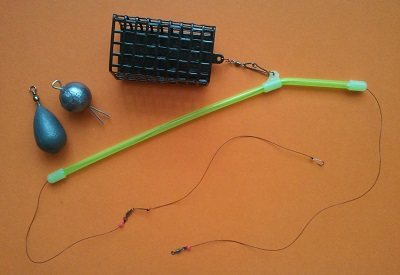
In strong winds and currents, large dimensions turned out to be necessary, and the main disadvantage of using a feeder near the surface was fully manifested. Along with good results in sport fishing, this method also acquired its followers, although in general it was considered less convenient than fishing with a fishing rod and float.
Installation of equipment - we assemble it ourselves
- When using up to 20 g of rigs, the main line is tied directly to the reel spool (when using heavier rigs, a shock leader up to seven meters long is tied to the spool, and the main line is tied to it;
- When installing a blind rig, the float is secured using one or two cambrics; when installing a sliding rig, two stop knots are knitted on the fishing line, then a stop bead is put on, then a float with a ring located in the keel part, and below it a small pellet is attached, which will serve as lower stop;
- Next, several pellet weights are attached to the fishing line; the fewer there are, the lower the likelihood of the tackle getting tangled;
- The leash can be tied to the main line using a swivel or using a loop-to-loop method; the optimal length for most situations is 20 - 40 cm.
